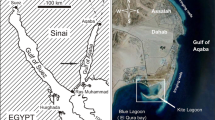Abstract
The surface traces and bioturbate textures genereated by the bubbler crabsScopimera sp.,Dotilla blanfordi, Ilyoplax pusilla, etc., occurring in the tropical supra- to shallow-subtidal environments of the east coast of India have been studied. During foraging these organisms make various patterns on the substrate by their feeding pellets. These patterns are primarily dependant on grain-size characteristics, moisture conditions, and emergence level of the substrate. The crabs also produce typical ichnofabrics caused by back-filling of the burrows which do not exceed 10 cm in length. The internal fabric of the burrow-fills shows both concave-upward and concave-downward laminae resulting from upward or downward movement of the organism within the sediment. In sections perpendicular to burrow orientation the process of back-filling generates concentric laminae. Such a fabric occurs not only in coastal intertidal sediments, but also in sediments of estuarine point bars located 50 kilometres inland where these tiny crabs also occur. Such subsurface bioturbation features may represent a better tool for the identification of tidal environment than surface traces since the latter have a low preservation potential because of the erosional effects of wave and current action. The bioturbate texture, however, occurs over a wide range of the intertidal zone and, hence, in fossil record this bioturbate texture can be useful to identify tidal environments. These crabs can withstand a definite range of salinity and, therefore, this texture can also provide information about salinity conditions of palaeo-tidal environments.
Similar content being viewed by others
References
Allen, E.A. &Curran, H.A. (1974): Biogenic sedimentary structures produced by crabs in lagoon margin and salt-marsh environments near Beaufort, North Carolina. — Journal of Sedimentary Petrology,44: 538–548.
Bouma, A.H. (1969): Methods for the Study of Sedimentary Structures. — 458 pp.; New York (Wiley & Sons).
Cadee, G.C., Guang, M.H. &Can, W.B. (1994): Animal traces on a tidal flat in Hangzhou Bay, China. — Netherlands Journal of Sea Research,32: 73–80.
Chakrabarti, A. (1972): Beach structures produced by crab pellets. — Sedimentology,18: 129–134.
Chakrabarti, A. (1981): Burrow patterns ofOcypode ceratophthalma (Pallas) and their environmental significance. — Journal of Paleontology,55: 431–441.
Chakrabarti, A. (1984): Problems in making relief peels and certain remedial measures. — Indian Journal of Earth Science,11: 249–254.
Chakrabarti, A. (2003): Large point bars in a monsoonal estuarine environment (east coast of India): An atlas of nearsurface sedimentary and biogenic structures. — Senckenbergiana maritima,32: 95–112.
Chakrabarti, A. &Das, S. (1983): Burrow patterns ofMacrophthalmus telescopicus (Owen) and their environmental significance. — Senckenbergiana maritima,15: 43–53.
Chakrabarti, A. &Hertweck, G. (1992): Unlined back-filled burrows: a result of biogenic activity of bubbler crabs in the tropical tidal flats of the Indian coast. — Abstr. Tidal Clastics 1992. Courier Forschungsinstitut Senckenberg,151: 16.
Droser, M.L. &Hughes, N.C. (1995): Infaunal communities and tiering in Ordovician shallow marine terrigenous clastic and carbonate settings: Ichnofabric and trace fossil evidence. — In:Cooper, J.D.,Droser, M.L. &Finney, S.C. [Eds.]: Odovician Odysee; Short papers for the Seventh International Symposium on the Ordovician System. — SEPM Special Publication,77: 405–408; Fullerton, CA.
Duncan, G.A. (1986): Burrows ofOcypoda quadrata (Fabricius) as related to slopes of substrate surfaces. — Journal of Palaeontology,60: 384–389.
Ekdale, A.A.,Bromley, R.G. &Pemberton, S.G. (1984): Ichnology, trace fossils in sedimentology and stratigraphy. — SEPM Short course,15: 317 pp.
Farrow, G.E. (1971): Back-reef and lagoonal environments of Aldabra Atoll distinguished by their crustacean burrows. — Symposium Zoological Society of London,28: 455–500.
Frey, R.W. &Mayou, T.V. (1971): Decapod burrows in Holocene barrier island, beaches and washover fans, Georgia. — Senckenbergiana maritima,3: 53–77.
Frey, R.W. &Pemberton, S.G. (1990): Bioturbate texture or Ichnofabric? — Palaios,5: 385–386.
Frey, R.W. &Pemberton, S.G. (1991): Or, is it ‘bioturbate texture’? — Ichnos,1: 327–329.
Frey, F.W., Curran, H.A. &Pemberton, S.G. (1984): Tracemaking activities of crabs and their environmental significance: the ichnogenusPsilonichnus. — Journal of Paleontology,58: 330–350.
Hayasaka, I. (1935): The burrowing activities of certain crabs and their geologic significance. — American Midland Naturalist,16: 99–103.
Hayes, M.O. (1979): Barrier island morphology as a function of tidal and wave regime. — In:Leatherman, S.P. [Ed.]: Barrier Islands from the gulf of St. Lawrence to the Gulf of Mexico: 1–27; New York (Academic Press).
Hertweck, G. (1972): Georgia coastal region, Sapelo Island, U.S.A.: V. Distribution and environmental significance of lebensspuren and in-situ skeletal remains. — Senckenbergiana maritima,4 (1/6): 125–167.
Hertweck, G., Wehrmann, A., Liebezeit, G. &Steffens, M. (2005): Ichnofabric zonation in modern tidal flats: palaeoenvironmental and palaeotrophic implications. — Senckenbergiana maritima,35 (2): 189–201.
Hill, G.W. &Hunter, R.E. (1973): Burrows of ghost crabOcypode quadrata (Fabricius) on the barrier islands, south central Texas coast. — Journal Sedimentary Petrology,43: 24–30.
Howard, J.D., Reineck, H.-E. &Rietschel, S. (1974): Biogenic sedimentary structures formed by heart urchins. — Senckenbergiana maritima,6 (2): 185–201
Krejci-Graf, K. (1935): Beobachtungen am Tropenstrand. — Senckenbergiana,17: 21–32.
Lee, Y.H. &Koh, C.-H. (1994): Biogenic sedimentary structures on a Korean mud flat: spring—neap variations. — Netherlands Journal of Sea Research,32: 81–90.
Ono, Y. (1965): On the ecological distribution of ocypodid crabs in the estuary. — Memoirs of the Faculty of Science Kyushu University, Series E Biology,4: 1–60.
Panzer, W. (1935): Sandkrabben-Spuren an der Küste von Neu-Guinea. — Natur und Volk,65 (3): 132–138.
Reineck, H.-E. (1962): Refliefgüsse ungestörter Sandproben. — Zeitschrift für Pflanzenernährung, Düngung und Bodenkunde,99: 151–153.
Reineck, H.-E. (1970): Reliefguß und projizierbarer Dickschliff. — Senckenbergiana maritima,2: 61–66.
Shin, H.C &Choi, J.Y. (2000): Distribution of macrobenthic community on Saemankeum tidal flat, west coast of Korea. — Tidalite 2000: Dynamics, Ecology and Evolution of Tidal Flats, Abstracts: 140–143; Seoul, Korea.
Weimer, R.J. &Hoyt, J.H. (1964): Burrows ofCallianassa major Say, geologic indicators of littoral and shallow neritic environments. — Journal of Paleontology,38: 761–767.
Author information
Authors and Affiliations
Rights and permissions
About this article
Cite this article
Chakrabarti, A., Chakrabarti, R. & Hertweck, G. Surface traces and bioturbate textures from bubbler crabs: an indicator of subtropical to tropical tidal flat environments. Senckenbergiana maritima 36, 19–27 (2006). https://doi.org/10.1007/BF03043700
Received:
Accepted:
Issue Date:
DOI: https://doi.org/10.1007/BF03043700




